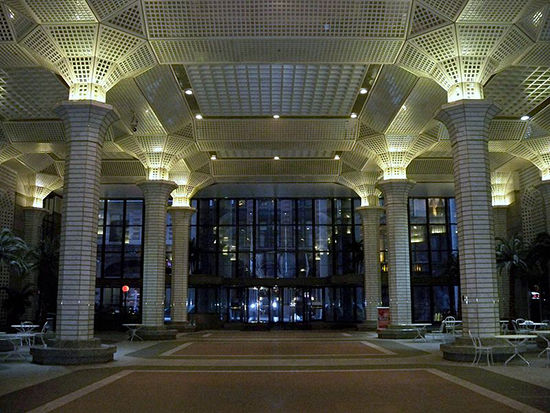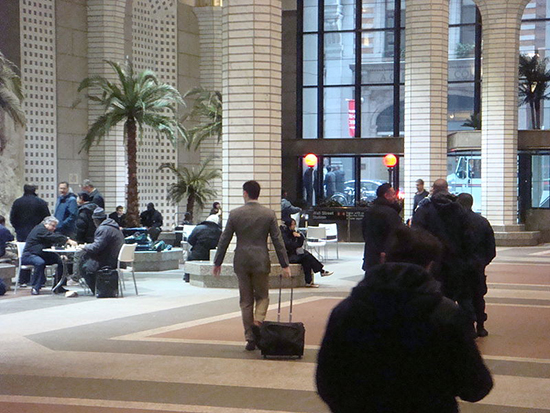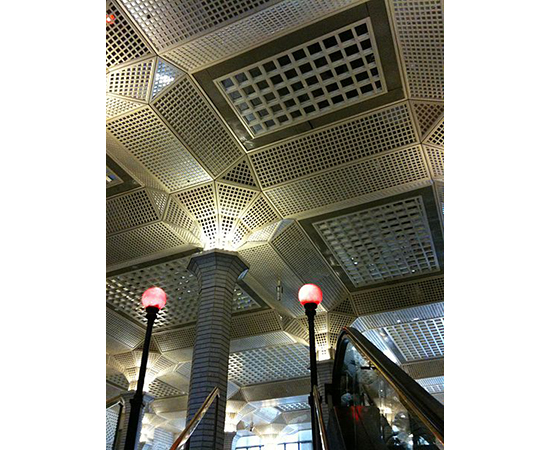A Tepid Defense of Privately Owned Public Space
In the Zone
In Tepid Defense of Privately Owned Public Space
An evening spent at 60 Wall Street. There is music: from the Starbucks, from the outside, from a snoring man’s fallen ear buds. There are lights, neon lights, bending and boasting “ICED LATTE” and “SMOOTHIE” and “CHEF HOT ENTREES,” all from the windows of a closed café. There is a coldness, between the tall ceiling and the marble floor, a gaping expanse of free space, or empty space. The nature—imported—felt cold, too. Furry trunks of squat palm trees marked distance between gray pillars. Who waters them? Along the walls, little plots of dirt, ferns, and tall sheets of rock curve and curve and pucker, forming accidental sculptures. Those things are still. Amidst the stillness are the people. Sitting, mostly, but also standing, also pacing. Entering and exiting. Men on their computers and men drinking coffee, and women, eating, and reading the paper.
“I’ve never had chicken soup. Bland, no pepper. I’ve had chicken, just not this bland.” A woman explains this to her silent friend, his head bowed. They are sitting in the far corner of the atrium. It is nearing seven on the evening of October 31st. Outside, men in skinny-leg suits are leaving the office late, then darting through the revolving doors and toward the Wall Street station, their heels clicking across the stone floor. They swarm, cluster, and disperse.
“Yeah,” the man says to woman, still holding her soup. The plaza fills, and empties, again. “Yeah.”

What is a privately owned public space? And where to start on the answer? The Advocates for Privately Owned Public Space define them as any “one of 525 or so plazas, urban plazas, residential plazas, public plazas, elevated plazas, arcades, through block arcades, through block gallerias, through block connections, covered pedestrian spaces, sidewalk widenings, [or] open air concourses” made available for public use by the city’s 1961 Zoning Resolution, which allowed developers to build with “greater density in certain high-density districts” provided they leave some scraps of their skyscrapers to the rest of us.
The 1961 resolution was the first major update to the city’s zoning law since 1919. In 1919, zoning laws were first introduced. As summarized in the New York City Department of City Planning’s “City Planning History,” the resolution, which divided the city into residential, commercial, and manufacturing areas, “accommodated a new type of high-rise office building with large, open floors of a consistent size,” while reducing residential densities elsewhere. The resolution drew up a new, hidden kind of map of the city, visible not immediately, but over time, through densities, through patterns, through feeling. It became visible, much later, in the skyline, where it is visible still, the changes trickling down from high above to far below, years and years after their legislative explosion, like starlight.
Along with the map, the 1961 resolution was the first to offer space incentives to developers. Buildings could grow taller if some amount of approved public space grew along with it. Hence: the private felt inclined to lend itself to the public. Hence: those 503 plazas, urban plazas, residential plazas, public plazas, elevated plazas, arcades, through block arcades, through block gallerias, through block connections, etc. Hence: 60 Wall Street.
Here are some numbers that might be interesting. 60 Wall Street, the headquarters of Deutsche Bank, contains 1.6 million square feet. The office building is fifty stories, which Deutsche currently leases as part of a 2007 Paramount and Morgan Stanley deal worth $1.2 billion (The Real Deal). Some space in the building is available now, or might be soon, and each square foot could go for as much as $750, as reported in an August 2016 article from The Real Deal. Off the side of 60 Wall Street’s appropriately ornate lobby sits 5,346 square feet of arcade and 11,150.10 square feet of covered pedestrian space. Or, about $12,372,075 worth of free space for the public to enjoy. But for all that money (granted, only a modest percentage of the buildings total cost) and all that space (granted, a space larger than afforded to many and most POPS) is any of it really being enjoyed?
You could answer that, quickly, and decisively, by spending time in a POPS yourself. Until then, here are some statistics offered in the introduction to the city’s electronic database of privately owned public spaces:
“Approximately 16 percent of the spaces are actively used as regional destinations or neighborhood gathering spaces, 21 percent are usable as brief resting places, 18 percent are circulation-related, four percent are being renovated or constructed, and 41 percent are of marginal utility.”
41 percent are of marginal utility.
Still, public-minded cynics will argue, it’s better than nothing. The developers will always develop. There will always be POs, with or without the PS. Knowing this, it is unsurprising that certain journalists and academic circles have devoted themselves to this PO/PS union, to improving it, to documenting and preserving it. POPS are an attractive professional cause for a number of reasons: they are visible, they are urban, they are a compromise. And, for many, there is no doubt some residual interest here that Occupy Wall Street sparked. Zuccotti is, after all, a POPS.
Study of and attention to privately owned public space has inspired plenty of interesting, important writing. Harvard professor Jerold S. Kayden, who quite literally wrote the book on POPS (Privately Owned Public Space: The New York City Experience,2000) has also founded the Advocates for Privately Owned Public Space, and created an interactive-map of city POPS and spaces to review and redesign them.
Any critique in this short overview comes back, as it always should for architects and developers, to one of use. Because the staunchest defenders of POPS, with Kayden as just one example, are not the ones you are at all likely to see putting these spaces to use, save for use in research. Perhaps that will change if POPS ever do move from places of “marginal utility” to ones that are useful, vital, and vibrant. In order to make this change, defenders must remember that POPS are not abstractions to consider but places to visit.
While an interesting entry point for theorists, urbanists, academics, and the like, the route to an accessible city, a welcoming city, is likely not via any partnership between money-minded developers and red-taped, well-intentioned bureaucrats. Even good-faith efforts to improve the zoning law, like a 2007 text amendment hoping to make future POPS more accessible, are still operating within a structure that ultimately benefits the people profiting at the top, and not the ones dwelling in the plaza below. Privately owned public spaces are not the only public space solution, even if Bloomberg-era reforms will have you think otherwise. There are already some public spaces in Manhattan that have benefitted their neighborhood, and that have done so without an accompanying office tower. The Lower East Side’s community gardens are little miracles of contrast. These meticulously maintained, genuinely inviting urban areas are the antithesis of every frustrating POPS failure. The green versus the gray. Integrated into the neighborhood, rather than thrust upon it. A destination in place of a waiting room.
So this is the context. And the context is important to know, and there is much more of it, too much to include, in the city’s long, slow war between the desires of developers, the actions of city government, and the needs of the people. But the history and the definition and the controversies and responses hardly do justice to our question. What are Privately Owned Public Spaces? To know the answer is to visit one yourself. Not as an accident, but with intention. To do so is to enter into a new kind of world, one whose experience is as much a conflict as its public/private name proclaims.

I have spent time—intentional time—in two Privately Owned Public Spaces. Wall Street in the fall and 153 East 53rd Street in the spring. The hour, the circumstance, the location was different, but each experience felt deeply the same. The stillness and the silence worked against the motion and the noise, and the motion and the noise were small, and still they felt transgressive. People seemed to convene within the arcades in spite of them. I spent around a full working day between the two: six hours uptown, three on Wall Street. It felt like years, sitting and watching, and it felt like no time at all.
Here are some notes from last spring: “A couple plays chess with grab-by-the-fist size pieces; a man presses duct tape over a power outlet; a woman in a felt hat takes a magnifying glass to a USA Today; upstairs, a security guard enters and immediately exits a 24-hour Fitness.” I remember that 24-hour Fitness. It was empty, save the guard, and the rows and rows of treadmills seemed to yearn for the lazy, infinite loops of the escalators next door.
Here are the notes from last fall: “A tracksuit and a business suit walk out of a Starbucks; rock formation is shaped like a family; a couple is talking next to me, talking in English. I listen (hard) and cannot understand anything they say.” Sitting at 60 Wall Street confirmed a feeling I had first felt last spring. A feeling that certain Privately Owned Public Spaces are not spaces at all, but portals, where you could spend an hour or spend a day and none of the real world, the outside world, could matter at all. I admit this is an abstraction think of it this way: To occupy the enclosed space of a Privately-Owned-Public is to occupy, on a literal, ground-floor level, a loophole. A loophole negotiated between two notoriously opaque realms (that of corporate real estate and city government), which eventually manifests as a thirty-eight-foot Frank Stella canvas and a row of spill-proof laminate tabletops jammed together in a sunken atrium uptown. Or as a rigidly organized forest of West-Coast-green palm trees (palm trees!) lined up next to a red subway pole. This is the gaudy, the impossible, among the modest, the practical. This is to say that all of it is a contradiction, from the initial contract to the finishing decor, and that being there feels like one.
Really, it is the chess people that fascinate me. In a place where the details are forever strange and frequently changing, the chess people are a constant. At 153 East 53rd street, there were the chess people. At 60 Wall Street, there were the chess people. At any park, in any part of the city, you can find them, too. Grown people and young people, winter and summer, groups of people and people playing alone.
Here is another question, to address the first: What does it mean to play a game of power in an environment where you have very little? POPS cannot help but display the power developers have over the physical space we are then subjected to. In a Wall Street POPS, the haves and the have-nots exist in something like harmony. A homeless man naps on a POPS bench as a finance man strides past him. For one, the POPS is permanence; for the other, the POPS is a passageway.

Why defend Privately Owned Public Space? Perhaps because pushing for anything better is unrealistic. Perhaps because it is already there, and need only be improved. Perhaps because some of these spaces are nice already, and offer a model of hope. But POPS, as with other incentive-based development regulations, ultimately serves the private more than the public. In defending these spaces, or even in offering face-lift improvements, are we instead reinforcing the existing system? Playing into its rules, in thinking we are playing against them?
It feels to me that these questions are the very reason POPS deserve our defense. The visual and emotional world is powerful, and POPS cannot help but illustrate a disparate tale of two cities in its very efforts to bridge them. The issue is not whether to raze these odd portals to the ground (in the interest of the developer), and it is not to stuff them with more palm trees and expensive sandwich chains (in the interest of the consumer). But to open ourselves to the value in POPS as they exist now, as monuments to the in-between world of what the city wants to be and what it has allowed itself to become.
It is unlikely POPS will change in any meaningful way, as their moral and aesthetic defenders will continue to balance out higher-level attempts to profit off of any remaining Manhattan square footage. But still, you should visit them. Not to gawk, but to view. To occupy the contradiction. And to spend your time, freely.
Work Cited
Kayden, Jerold S., et al. Privately Owned Public Space: The New York City Experience. Wiley, 2000.
“About”. Advocates for Privately Owned Public Space, The Municipal Art Society of New York, and Jerold S. Kayden. Web. October 2, 2017.
“City Planning History”. Department of City Planning, City of New York. 2016. Web. October 2, 2017.
“Privately Owned Public Space”. Projects and Proposals. Department of City Planning, City of New York. October 17, 2007. Web. October 2, 2017.
“Paramount, Morgan Stanley shop majority stake at 60 Wall St.” The Real Deal. Korangy Publishing, Inc., August 24, 2016. Web. October 2, 2017.